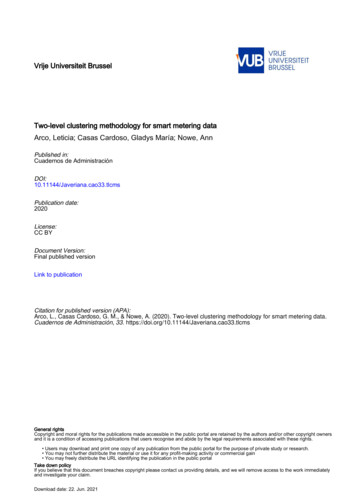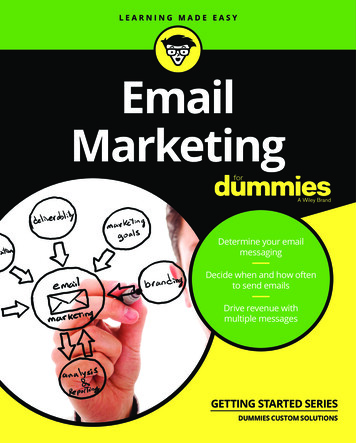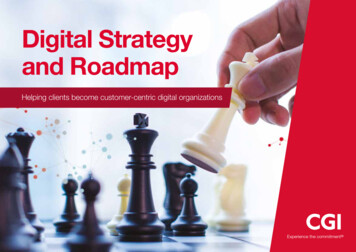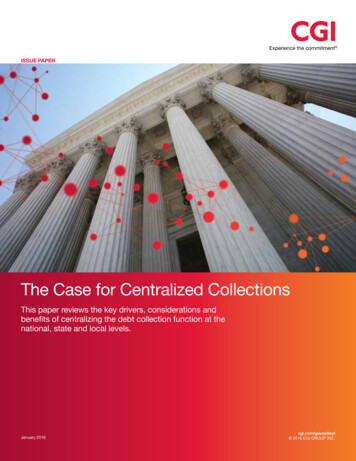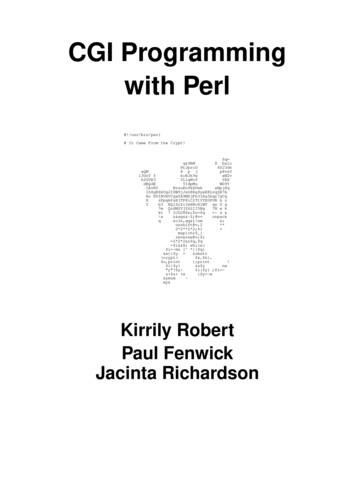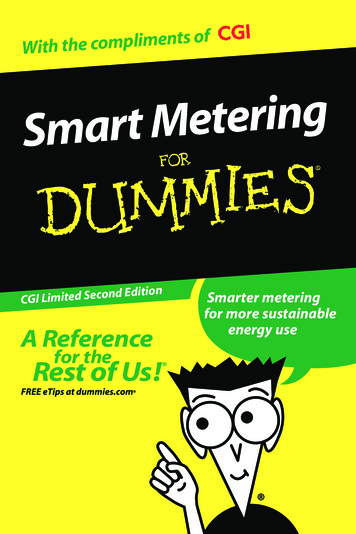
Transcription
ts ofWith the complimengnireteMtraSmEditionCGI Limited SecondSmarter meteringfor more sustainableenergy use
Smart MeteringFORDUMmIES‰2ND EDITIONBy Chris Beard, CGIA John Wiley and Sons, Ltd, Publication
Smart Metering For Dummies Published byJohn Wiley & Sons, LtdThe AtriumSouthern GateChichesterWest SussexPO19 8SQEnglandE-mail (for orders and customer service enquiries): cs-books@wiley.co.ukVisit our Home Page on www.wiley.comCopyright 2010 by John Wiley & Sons Ltd, Chichester, West Sussex, EnglandAll Rights Reserved. No part of this publication may be reproduced, stored in aretrieval system or transmitted in any form or by any means, electronic, mechanical, photocopying, recording, scanning or otherwise, except under the terms of theCopyright, Designs and Patents Act 1988 or under the terms of a licence issued bythe Copyright Licensing Agency Ltd, 90 Tottenham Court Road, London, W1T 4LP,UK, without the permission in writing of the Publisher. Requests to the Publisherfor permission should be addressed to the Permissions Department, John Wiley &Sons, Ltd, The Atrium, Southern Gate, Chichester, West Sussex, PO19 8SQ, England,or emailed to permreq@wiley.co.uk, or faxed to (44) 1243 770620.Trademarks: Wiley, the Wiley Publishing logo, For Dummies, the Dummies Manlogo, A Reference for the Rest of Us!, The Dummies Way, Dummies Daily, The Funand Easy Way, Dummies.com and related trade dress are trademarks or registeredtrademarks of John Wiley & Sons, Inc. and/or its affiliates in the United States andother countries, and may not be used without written permission. All other trademarks are the property of their respective owners. Wiley Publishing, Inc., is notassociated with any product or vendor mentioned in this book.LIMIT OF LIABILITY/DISCLAIMER OF WARRANTY: THE PUBLISHER, THE AUTHOR, ANDANYONE ELSE INVOLVED IN PREPARING THIS WORK MAKE NO REPRESENTATIONS OR WARRANTIES WITH RESPECT TO THE ACCURACY OR COMPLETENESS OF THE CONTENTS OF THISWORK AND SPECIFICALLY DISCLAIM ALL WARRANTIES, INCLUDING WITHOUT LIMITATIONWARRANTIES OF FITNESS FOR A PARTICULAR PURPOSE. NO WARRANTY MAY BE CREATEDOR EXTENDED BY SALES OR PROMOTIONAL MATERIALS. THE ADVICE AND STRATEGIES CONTAINED HEREIN MAY NOT BE SUITABLE FOR EVERY SITUATION. THIS WORK IS SOLD WITHTHE UNDERSTANDING THAT THE PUBLISHER IS NOT ENGAGED IN RENDERING LEGAL,ACCOUNTING, OR OTHER PROFESSIONAL SERVICES. IF PROFESSIONAL ASSISTANCE ISREQUIRED, THE SERVICES OF A COMPETENT PROFESSIONAL PERSON SHOULD BE SOUGHT.NEITHER THE PUBLISHER NOR THE AUTHOR SHALL BE LIABLE FOR DAMAGES ARISING HEREFROM. THE FACT THAT AN ORGANIZATION OR WEBSITE IS REFERRED TO IN THIS WORK ASA CITATION AND/OR A POTENTIAL SOURCE OF FURTHER INFORMATION DOES NOT MEANTHAT THE AUTHOR OR THE PUBLISHER ENDORSES THE INFORMATION THE ORGANIZATIONOR WEBSITE MAY PROVIDE OR RECOMMENDATIONS IT MAY MAKE. FURTHER, READERSSHOULD BE AWARE THAT INTERNET WEBSITES LISTED IN THIS WORK MAY HAVE CHANGEDOR DISAPPEARED BETWEEN WHEN THIS WORK WAS WRITTEN AND WHEN IT IS READ.Wiley also publishes its books in a variety of electronic formats. Some content thatappears in print may not be available in electronic books.ISBN: 978-0-470-74164-1Printed and bound in Great Britain by Page Bros, Norwich10 9 8 7 6 5 4 3
IntroductionWelcome to Smart Metering For Dummies, yourguide to the exciting new world of smart metering and the impact that it’s likely to have on the utilitiesmarket and beyond.About This BookThe words ‘exciting’ and ‘metering’ rarely make it intothe same sentence – but all that’s about to change. Smartmetering is not only set to revolutionise the meteringservices sector, it’s also the catalyst for the singlebiggest wave of change to hit the utilities industrysince the introduction of retail competition. This bookexplains the why, how, and when of smart metering andits effects on customers, suppliers, and distributors.To keep things simple, we use the term ‘smart’ to referto smart meters and ‘conventional’ to refer to existingmeters.Foolish AssumptionsIn writing this book, we’ve made some assumptionsabout you. We assume that: You work in the utilities sector and understand thebasics of how the electricity and gas markets work. You want to know more about smart meteringand how it will affect suppliers, distributors, andcustomers.
2 You understand some of the utilities and meteringjargon (we include a glossary at the back of thebook, just in case).How This Book is OrganisedSmart Metering For Dummies is divided into six conciseand informative sections: Part I: Get Smart. We discuss the business drivers behind the move from conventional to smartmetering and the benefits to be realised by thekey stakeholders. Part II: What is a ‘Smart’ Meter? We explain whatmakes a meter smart and how it differs from itsconventional cousin. Part III: The Anatomy of an Advanced MeteringInfrastructure. We describe the key componentsof the infrastructure required to support smartmetering and attempt to demystify some of theassociated smart jargon. Part IV: Feeling the Impact of Smart Metering. Inthis section we take a look at how the key stakeholders will be affected by the smart revolution. Part V: Looking to the Future. Smart meteringwon’t happen overnight. In this part we examinesome of the long-term parallel activities that willinfluence, or be influenced by, a smart meteringrollout. Part VI: Top Ten Smart Tips. This nifty part is alist of the essential things to remember aboutsmart metering.
3Icons Used in This BookTo make navigating to particular information eveneasier, these icons highlight key text:The knotted string highlights important information to bear in mind.The Dummies man indicates real-life anecdotes to illustrate a point.Where to Go from HereAs with all For Dummies books, you can dip in and outof this book as you like, or read it from cover to cover –it won’t take you long!Use the headings to guide you to the information youneed. If you require any more information, feel free tovisit us at www.cgi-group.co.uk/utilities.
Part IGet SmartIn This Part䊳 Exploring the move towards smart metering䊳 Discovering the benefits for the customer, supplierand distributorWe’re all responsible for climate change. Forexample, UK residents contribute over 40% ofthe country’s carbon dioxide (CO2) emissions andenergy usage. In this country alone, leaving domesticappliances on standby when not in use cost over 900million in 2008! To address this, everyone needs tobecome more energy savvy. With soaring fuel pricesand more and more families falling into fuel poverty,the motivation for a change in behaviour is growing.What’s missing is the information required to makesmarter decisions.This part looks at the drivers for introducing smartmetering and examines the benefits for some of the keystakeholders.
5Driving towards Smart MeteringSmart metering provides: Customers with the information they require tobecome energy savvy and make smarter decisionsabout their energy usage. Suppliers with the means to better understandand service their customers. Distributors with an effective tool to better monitor and manage their networks.In addition, smart metering enables those customers who choose to produce their own electricity from microgeneration in addition toconsuming from the grid (so called “prosumers”) to be financially rewarded for theircontribution . It also helps distributors tobetter manage this contribution.What’s in it for the customer?Individuals need to understand their energy consumption in order to make intelligent decisions about it.Currently, customers are informed of their energy usevia a bill that arrives months after they’ve used the gasor electricity. The bill typically only tells the customerthe cumulative consumption since the last bill and,more often than not, even this is estimated. It isn’t surprising that customers don’t feel empowered tomanage their energy use.But providing individuals with the timely, accurate, anddetailed information they require to take control oftheir energy use is only one of the benefits that smartmetering can bring. Other benefits include:
6 Estimated bills will become a thing of the past.Customers will know what they owe and will beable to budget better. New, innovative tariffs will appear, tailored tomeet the needs of specific customers’ lifestyles. Customers will get better service such as ondemand readings (for example, on changing supplier or moving home). Smart meters will measure electricity generatedfrom domestic microgeneration, enabling socalled “prosumers” to be financially rewarded fortheir contribution.What’s in it for the supplier?For the energy supplier, smart metering will enable thetransformation from an energy supply company to anenergy services company. Smart metering will allow asupplier to get closer to its customers, to better understand and service their needs, and, at the same time,allow the supplier to reduce its operating costs: The cost to service customers will reduce withincreased customer self-service. Suppliers willhave fewer bill queries, complaints, and site visits.Call centre staff will become more productive. Meter reading costs will reduce dramatically asmeters are read remotely. Suppliers will be able to differentiate themselvesthrough an extended range of products and services offered into the home.
7 Timely consumption information will allow suppliers to better manage customer debt. Energy theft will be reduced through smarttamper alarms. Improved visibility and control of customers’ consumption behaviour will enable suppliers tobetter balance their wholesale positions.But in addition to ‘smartening’ up their existing operations, smart metering also presents suppliers with ameans to differentiate through pioneering new products and services, thus creating a new battleground forretail competition where the customer-savvy and innovative supplier will triumph.What’s in it for the distributor?Smart metering offers distributors the opportunity toextend their much heralded ‘smart grids’ to individualcustomers on the low voltage networks. Indeed, inmany countries, the desire for smarter grids is the keydriver for the introduction of smart metering (checkout Part VI).Here are some of the benefits that smart metering willbring to distributors: Smart metering will provide distributors with theability to more accurately bill suppliers for use ofthe distribution networks in delivering electricityto their customers. Functionality within smart meters will enablesystem faults to be notified and located morequickly following power cuts and interruptions.
8 Smart metering will give distributors better visibility of their networks, enabling more cost-effectivemaintenance regimes. More detailed consumption data will enable distributors to measure, rather than model, networklosses, reducing the need for reconciliations andproviding greater revenue certainty. As with suppliers, distributors will benefit fromreduced theft through smart tamper alerts. Smart metering presents the opportunity of activedemand management, controlling load at individual premises to better manage the network.Who else stands to benefit?Everyone stands to benefit from smart metering: The increased use of remotely managed Time ofUse (ToU) and block tariffs (see Part II) will helpspread energy consumption more evenly acrossthe day, easing the stress on distribution networks and reducing the need for costly generatingplant to meet the peak demand. An overall reduction in energy consumption instigated by an energy-savvy public will reduceimpending gaps between forecast demand andgeneration and help restore security of supply. Less consumption means less CO2 emissions andless climate change.
Part IIWhat is a Smart Meter?In This Part䊳 Discovering what makes a meter smart䊳 Unearthing the smart impostorsWhat exactly is a smart meter and why is it cleverer than the little box currently stuck on thewall? This part looks at what makes a meter smart andhow it differs from its conventional predecessors.Smarter than YourAverage Meter .So what makes a meter smart? Traditionally, meters situnder your stairs or in the garage and are only disturbed when the meter reader comes to take a reading.Well, at first sight, smart meters don’t look a whole lotdifferent as you can see in Figure 2-1. Like their conventional cousins, they still sit in infrequently visited locations, but now they’re not even disturbed by meterreaders.
10Figure 2-1: These meters look similar but are a world apart.Surprisingly, there’s no absolute definition of what asmart meter is and this lack of a universal standard isan obstacle to many national smart meter rollouts(which we talk about in Part IV).However, this section delves into the widely-acceptedcharacteristics of a smart meter.Two-way communicationIn addition to being remotely read, smart meters canbe remotely instructed and re-configured. Actionswhich, in the case of conventional meters, necessitatelengthy site visits and meter changes, can now be performed remotely in near-real time.Actions that can be remotely performed with a smartmeter include:
11 On-demand meter readings. For example, readinga meter in near-real time in response to a customer phoning the call centre. Change of tariff. Changing tariff rates and tariffstructures in response to a supplier-instigatedprice change or a customer electing to move to anew, innovative smart tariff, for example. Change of payment method. Switching betweencredit and pre-payment modes. Change in read frequency. Changing the consumption read interval from, say, monthly to dailyor even sub-hourly. Load limiting/shedding. Remotely controlling anagreed portion of a customer’s consumption inorder to help balance generation and demand or asa means for preventing customers from running upmassive debts while still having access to energy. Tamper alerts. Automatically detecting, notifying,and responding to attempts to tamper with themeter. Disablement/enablement. Turning supply on andoff in response to, say, a tamper alert. Messaging. Communicating directly with the customer via the smart meter and Home Display Unit(HDU – described in Part III). Firmware updates. Remotely updating the software embedded within the smart meter in orderto fix bugs or add new functionality.
12Detailed consumptionSmart meters are capable of recording consumptionin far more detail than their less sophisticated, conventional cousins. Meter readers typically visit everyquarter but not always when you’re at home! So thelevel of consumption information available to customers and suppliers is pitiful. Suppliers have no meansof encouraging people to change consumption behaviour and customers have no means of knowing whattheir consumption behaviour is!Smart meters can record very detailed Time ofUse (ToU) consumption down to sub-hourly.ToU refers to a meter’s ability to record whenconsumption takes place rather than just howmuch is consumed. Customers can see howtheir consumption varies during the day andrespond to new ToU-based lifestyle tariffs thatencourage them to use cheaper energy. Changesin behaviour can have the effect of flatteningconsumption peaks which, in turn, reduce theneed for expensive, carbon-polluting peakingplant and network reinforcement.Not just electricitySmart meters exist for commodities such as gas andwater as well as electricity. Given that electricity doesn’tmix well with either gas or water, gas and water smartmeters tend to be battery-powered. Battery technologyis constantly improving but, to avoid the costs of sitevisits to replace batteries, these meters tend to spend alot of the time asleep, waking up according to a scheduleto take and transmit readings.
13Time to find out about Time of Use (ToU)A meter that can record ToU is called a ‘restricted’ meter andrecords consumption by having different registers active atdifferent times. For example, a restricted two-rate meter mayhave one register that records consumption overnight andanother that does so during the day. This enables the supplierto apply different tariff rates that reflect the differentialbetween the wholesale cost of day-time and night-timeelectricity.Smart electricity meters, on the other hand, have readyaccess to a power supply and are therefore frequentlyused as the means of communicating data from gas andwater smart meters. The gas and water smart meters‘piggy-back’, by communicating via low-power radio tothe electricity smart meter, which stores and forwardsthe data as additional registers within its own meter.Export as well as importWhereas conventional domestic meters only recordconsumption, most smart meters are also capable ofrecording electricity generated from domestic microgeneration plants and exported to the distribution grid.The ability to measure the output from microgeneration means that “prosumers” can be fairly rewarded fortheir contributions, which makes smart meters one ofthe key enablers for the widespread adoption of microgeneration.
14Not quite smart enough .The following technologies often arise in smart meterconversation but shouldn’t be confused with the realthing. Automatic Meter Reading (AMR). An AMR metercan be read remotely but reading the meter is theonly remote function supported. The benefits ofAMR metering are restricted to reducing meterreading costs to the supplier and the ability to billthe customer based on actual meter readings. Clip-on electricity monitors. These little devicesare sensors that clip onto the cables feeding conventional electricity meters and wirelessly transmit near-real time consumption information to aportable display unit located elsewhere in thehouse. The display unit shows how much electricity is being consumed and how much CO2 thisrepresents.However, clip-on electricity monitors have significant limitations when compared to smart meters.There’s no equivalent clip-on monitor for gas orwater meters, no remote supplier access (so noneof the supplier or distributor benefits of smartmetering can be realised), and no improvement inbilling because the supplier still has to manuallyread the meter.
Part IIIThe Anatomy of an AdvancedMetering InfrastructureIn This Part䊳 Thinking about what’s needed to support smartmetering䊳 Communicating with a smart meterSmart meters require different bits and pieces tosupport them and this part describes the majorcomponents required.Home Display Units (HDUs)Home Display Units (HDUs; referred to as In-HomeDisplay Units) (IHUs) or Customer Display Units (CDUs)are the devices that you put on your wall or fridge toinform you about your energy consumption.Communicating wirelessly with the smart meter (eitherdirectly or via the Home Area Network which weexplain in the following section), the HDU displaysnear-real time information on energy usage, cost andgreenhouse gas generation for both gas and electricity.A common feature is a coloured light indicator to tellyou when to run around switching things off!
16It’s fair to say that HDUs have a way to go to becomingthe must-have stylish home accessory but it’s only amatter of time . . .Home Area Networks (HANs)The Home Area Network enables devices and appliances to communicate with each other. The obviousexample is the smart meter and the HDU. However,appliance manufacturers are becoming more and moresavvy to the idea of home networking. The vision of a‘smart home’, in which appliances, lighting, heatingand security are connected and automatically controlled to save energy and improve occupant wellbeing, isn’t far away.Wide Area Networks (WANs)What makes a meter smart is its ability to hold a twoway conversation with a data communication (or‘head-end’) system. The medium over which thiscommunication occurs is called the Wide AreaNetwork (WAN).Although, in principle, smart meters couldhave their own dedicated WAN, a number ofcommunication infrastructures are already inplace that are capable of fulfilling the WANrole. These include the copper and fibre networks of fixed line telephony providers, thecellular networks of the mobile phone operators, and the power lines of the electricity distribution networks.
17Data Communication systemThe data communication, or ‘head-end’, system isresponsible for pulling together data from a large anddisparate set of smart meters. It handles two-waycommunication, sending service requests to the meterand receiving messages such as scheduled meter readings. In order to communicate with a smart meter, ahead-end system must ‘speak’ that meter’s protocol.Unfortunately, there’s currently no smart meter equivalent of Esperanto, so head-end systems need to be multilingual. Alternatively, a smart metering solution can usemultiple head-end systems or stick with one meter manufacturer to standardise on a single protocol.Meter Data Management(MDM) systemsSmart meters can produce a prodigious amount of datacompared to their conventional cousins, which typically only record non-interval data (meaning dataobtained only when someone manually reads it, usuallyonce every three months). Smart meters, however, arecapable of recording interval consumption (meaningconsumption data automatically recorded at a predefined interval, typically every 30 minutes (in theUK).) So a smart meter can produce over 4,000 times asmuch data a year as its conventional counterpart.An MDM system is a single repository capable ofreceiving, validating and storing the vast quantities ofmeter readings and other data associated with smartmeters. It typically gathers data from one or morehead-end systems.
18Data portalGathering vast quantities of metering data is all verywell but has little benefit unless that data can be transformed into valuable information and made available tothose who will act on it. A data portal is the means bywhich the data collected in the MDM system is madeavailable to whoever needs it – the customer, supplier,or distributor. Some MDM products also include dataportal functionality.How Do I Talk toa Smart Meter?When industry types start talking about smart meters,the conversation inevitably turns to communicationtechnologies. So here’s a quick primer so that you canhold your own at the coffee machine.You can communicate with a smart meter in anumber of ways, each having its own advantages anddisadvantages: Power Line Carrier (PLC): Also known as PowerLine Communication, PLC technology carries dataacross the same power line that’s used to deliverelectricity. Meters talk to a smaller number of concentrators (communication devices) across thepower lines. The concentrators then talk to thecentral head-end system via another communication technology such as GPRS (explained in amoment).The major advantage of PLC is that it’s effectivelyfree. Disadvantages are the need for concentra-
19tors and the fact that, due to power lines beinginherently noisy environments, communicationsoften need to be repeated, leading to slowerresponse times. Broadband over Power Line (BPL): Also knownas Power Line Internet, BPL is the use of PLC technology to provide broadband through ordinarypower lines. Using BPL, a smart meter can enjoy avirtually free, always-on connection to the centralhead-end system. However, as with PLC, BPLrequires concentrators and is subject to line noisewhich often requires a large number of repeatersto boost the signal. General Packet Radio Service (GPRS): GPRS is apacket-orientated mobile data service that can beused to provide an always-on wireless connectionbetween a smart meter and a central head-endsystem. GPRS uses a mobile operator’s WAN andrequires the smart meter to be fitted with a proprietary SIM card. Unlike BPL, the connection isn’tfree but is typically charged per megabyte of datamoved. However, it can cope with large volumesof data (for example, when updating a smartmeter’s firmware). Short Message Service (SMS): Also known as textmessaging, SMS involves sending fixed size textmessages via a mobile operator’s WAN using aSIM card installed within the smart meter. WhileSMS can have a broader coverage than GPRS, thefixed “short” nature of the message means that itis less suited to the transfer of large data volumes. Radio: Radio waves can be used to communicatewith smart meters either locally (low power radio)
20or long range (licensed or private frequency). Bothrequire additional infrastructure (for example, concentrators and/or dedicated radio masts). Wi-Fi: Wi-Fi is the trade name for a popular wireless technology that enables a device to make awireless connection to the Internet via an accesspoint (or hot spot). The advantage of Wi-Fi is thatit’s relatively cheap to Wi-Fi-enable a smart meter.The disadvantage is the limited coverage of hotspots due to the fairly high power requirements. ZigBee: ZigBee is a low-cost, low-power wirelessmesh networking standard. Like Wi-Fi, communication via ZigBee is cheap. However, it’s best suitedfor local coverage such as Home Area Networks(HANs).Keeping Smart SecureThe end-to-end security of the smart metering infrastructure, from smart appliances in the home to anenergy company's IT systems, is a vital considerationin its design. Maintaining the public's confidence thattheir uninterrupted access to energy will not beaffected and that their personal data remains secure iscrucial.Different parts of the end-to-end smart metering infrastructure have different types and levels of risk associated to them. The good news is that similar risks arefaced and are effectively managed in other sectorstoday.In many sectors, access to individuals' personal dataheld in IT systems is kept secure through a combination of technical and procedural measures. Thetelecommunications sector maintains the security of its
21networks through controlling the types of devices thatcan be connected to their infrastructure through thedefinition of standards in Codes of Connection(CoCos). Devices are identified and securely connectedwith communication gateways or routers through theentry of security keys or codes. Many connecteddevices receive regular updates based on the proactive identification of new threats.A secure smart metering infrastructure will build onthe learning of other sectors. CGI is drawing on theknowledge and experience of our Security practice toensure that our clients and their customers can haveconfidence in the security of their smart meteringsolutions.
22
Part IVFeeling the Impact ofSmart MeteringIn This Part䊳 Looking at the effect of smart metering on cus-tomers, suppliers and distributors䊳 Sharing success storiesSmart metering will have a profound effect on customers and the utilities that service them. Here,we consider some of these impacts through referenceto real-life examples.Impact on CustomersSo, what impact will a smart meter have on your average customer?Better informedA key objective of smart metering is to make customersmore energy savvy. The timely provision of detailedconsumption information will empower customers tomake smarter choices about how and when they useenergy. Given the continued upward trend in world
24energy prices, this empowerment is bound to appeal tocustomers and increase their expectations of the service they receive from their energy suppliers.Better billedA welcome customer benefit of smart metering is thedemise of the estimated bill. Infrequent meter readingsand poor access rates mean that many customers aremore than often not billed on estimated, rather thanactual, consumption. This can result in customersunknowingly running up significant debts and exacerbating the problem of fuel poverty.Energy savvy SwedesThe 22,000 inhabitants of Växjö, a city in Sweden, are nowmore energy savvy thanks to an energy-efficient urban development project sponsored by the European Union (EU).Householders are now able to analyse their energy usage viaa web-based system developed by CGI. The purpose of thesystem is to increase customers’ energy awareness by makinganalysis simple and informative. The system includes a competitive element, enabling householders to compare consumption with peers and compete for prizes based onreductions in their energy consumption.Ann-Mari Ståhlberg, President of Växjö Energi AB, said: ‘Withthis solution, we’re able to offer our customers something wealways aim for, namely, the opportunity to influence andincrease the efficiency of electricity consumption.’(The project referenced in this example, and all examples inthis book, was delivered by Logica, which CGI acquired inAugust 2012.)
25Getting the bills rightSwedish legislation demands that all electricity meters mustbe read once every month. Energy company Vattenfall’s solution to this challenge was to deploy smart meters to its customers and, with CGI as a key partner providing the AdvancedMetering Infrastructure, has now installed over 150,000 smartmeters.Hundreds of thousands of meters reporting daily creates veryhigh volumes of data. Despite these volumes, the system hasexceeded its reliability targets, consistently running at levelswell above 99.5 per cent of collected values in a 24-hourperiod. As a result, Vattenfall experiences higher levels of satisfaction among its customers and fewer calls querying bills,because the bills are based on up-to-date information.Furthermore, the system provides information about poweroutages and power return for each customer, creating a valuable quality control resource.Erik Nordgren, Head of AMR Project Vattenfall EldistributionAN Sweden said: ‘There’s no question that automated metering has helped us deliver better customer service.’With smart meters, readings are available on-demand.Smart meters are typically read more frequently than acustomer is billed. However, on-demand meter readingscan also be taken in-line with a customer’s billing cycleor a price change to ensure that every bill is based onactual consumption.Wit
The Dummies man indicates real-life anec-dotes to illustrate a point. Where to Go from Here As with all For Dummies books, you can dip in and out of this book as you like, or read it from cover to cover – it won’t take you long! Use the headings to guide you to the information yo
